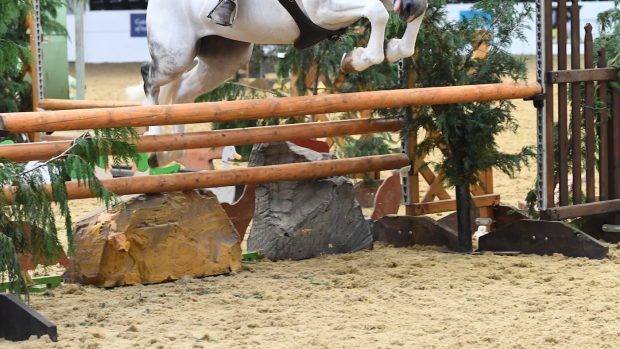New to the horse working hunter scene, or want to refresh your mind before the season gets underway?
Read some essential need to knows about the popular showing class…
Class format
Riders are required to jump a course of rustic fences. In horse ranks, a ride judge will then officiate the performance. Conformation is also assessed before the marks for each section are added together to produce the final line-up.
There is 100 marks to win. The jumping section is worth 60% of the marks; 40 marks for the jumping round and 20 marks for style and presence. The ride and conformation is worth 20 marks each.
Horses usually compete together or in separate lightweight and heavyweight sections.
At the Royal International (RIHS) there are separate lightweight and heavyweight classes, while all finalists compete together for one title at Horse of the Year Show (HOYS).
Eligibility
A working hunter can be a mare, gelding or stallion four-years-old or over (competing stallions must have a red, white and blue ribbon displayed in their tail or a stallion disc displayed.)
According to the British Show Horse Association (BSHA) rule book, restricted working hunters must not have qualified for RIHS or HOYS in the current year as a working hunter.
Novice working hunters are not to have won a first prize of £35 or more than a total of £250 (including any championship prize money) in a working hunter class.
Grade-A showjumpers and advanced event horses are not eligible to compete in these classes.
In addition to this, any horse which has qualified as a grade-A showjumper or an advanced event horse as of 1 January in the current year is not eligible to compete working hunter classes.
Rider turnout
Whether you are competing in a working hunter class at county level, or at your local village show, you need to ensure your turnout is both correct for the class and of the highest standard to impress the judges.
Make sure your tack is supple and spotlessly clean and ensure your horse’s plaits are perfect so you enter the ring looking the part.
A correctly secured skull cap or riding hat that meets current safety standards must be worn by riders at all times when jumping under BSHA rules.
Traditional velvet hats with a flesh coloured harness and a fixed peak are in keeping with traditional hunting dress, but a skull cap with a smart velvet or silk cover is acceptable, and the latest fixed peaks hats are also being seen.
A classic tweed jacket is correct for daytime classes, while a navy jacket should be worn for evening championships.
Badly fitting jackets and ‘tack that could stand up on its own’ are common blunders, so if you have a jacket that is less than a perfect fit, take it to a tailor to be altered and gain that professional edge.
You should wear long, black leather boots. Traditionally these would have straight tops and garter straps, but long black boots with curved tops are increasingly being seen.
Jodhpurs or breeches need to be canary or beige, not white, and your shirt should match. A stock or tie can be worn in a toning colour with tan or brown gloves.
Hair should be neatly secured in a hairnet and tied back with a scrunchie if necessary.
A body protector is recommended for the jumping phase of working hunter classes, and is compulsory in working hunter pony classes held under British Show Pony Society rules.
Continued below…

What do I wear in my horse or pony showing class? Read our dress code guide for show riders…

Subscribe to Horse & Hound magazine today – and enjoy unlimited website access all year round
Horse turnout
Tack for working hunter classes should be plain in either dark havana or black leather. There are no restrictions on bits, martingales or nosebands.
Bridles should be plain with no bling or anything coloured. Rolled or padded browbands and nosebands are acceptable as long as they are all in the same colour. So for example, no white piping/padding.
It is important to note that there must be no change of tack between the jumping and flat/ridden phases, so if you decide to wear a martingale for the jumping, it must stay on for the whole class.
The only exception to that rule is protective boots. Dark-coloured brushing boots are allowed for the jumping phase, but must be removed before the ridden judging. The inside of the boot must be smooth, the fixations must be non-elastic velcro and no hooks or straps may be used. The rounded rigid part of the boot must be placed around the inside of the leg. No hind boots or bandages are permitted in senior classes.
If a numnah is required it should match the tack, be kept close to the saddle and not interfere with the shoulder. Saddlecloths are not appropriate. The girth should be a dark colour, preferably leather to match the saddle.
If a rider is short or has small stirrups they should ensure their ‘groom’ brings a spare pair of stirrups into the ring so that the judge can use them when they ride.
Horses should be shown with plaited manes, and tails should be pulled at the dock and shortened to hock level when carried. Any feathering at the fetlock should be trimmed, as should the ears, jawline and whiskers.
Would you like to read Horse & Hound’s independent journalism without any adverts? Join Horse & Hound Plus today and you can read all articles on HorseandHound.co.uk completely ad-free




